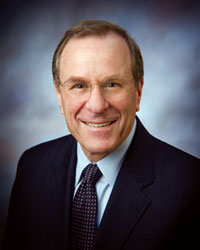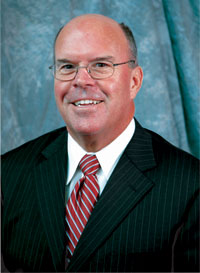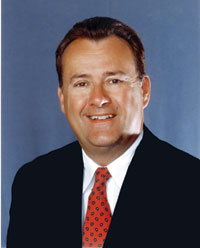 It’s a surprising move. It may be a risky move. It’s a move that, if successful, should change how Oregon’s economic department does business with the world and with the state itself.
It’s a surprising move. It may be a risky move. It’s a move that, if successful, should change how Oregon’s economic department does business with the world and with the state itself.
Split decision
The governor plans to break up the state’s economic development department. Will it work this time?
By Abraham Hyatt
|
It’s a surprising move. It may be a risky move. It’s a move that, if successful, should change how Oregon’s economic department does business with the world and with the state itself.
Gov. Ted Kulongoski wants to shift the emphasis of the Oregon Economic and Community Development Department to business development, rather than focusing on both business and community development. Community development wouldn’t be eliminated; instead it would be an adjunct partner. Both would remain under the umbrella of OECDD.
OECDD, which is operating on a $414.6 million budget for the current biennium, uses tax incentives, grants, loans, technical support and other programs to help municipal agencies, private industry and nonprofits with business and community development. Its scope is broad. For instance, Brand Oregon, the development of industry clusters and community development block grants all fall under the agency’s purview.
Those in the governor’s office who have been crafting the proposal — economic development director Tim McCabe and director of strategic development Nancy Hamilton — say restructuring is an essential step for the future of the state’s economy.
The proposal targets macro-level woes: OECDD’s mission is too broad; using job creation as the only definition of success doesn’t fit all the agency’s work; the agency’s structure prohibits it from keeping up with the pace of business.
“It doesn’t work the way we’re going,” says McCabe.
There are no specific problems — lost jobs or failed business projects — as yet being detailed by McCabe and Hamilton. They say individual issues have nothing to do with the proposal and that the point is to create an agency that’s more nimble when it comes to global competition, business development and handling Oregon’s infrastructure demands.
THIS IS NOT A UNIQUE IDEA. Restructuring has been suggested and debated several times since community development was brought into the same agency as economic development under Gov. John Kitzhaber in the mid 1990s. In fact, Sen. Rick Metsger, D-Welches, plans to bring his own unrelated proposal for reorganizing the OECDD to the Legislature in 2009.
But there’s no guarantee of success. Current and former directors of the agency see the benefits but also question whether a division will do more harm than good. They say the two sides of the agency are too intertwined, too interdependent for a successful separation.
OECDD director Bob Repine, who was appointed two years ago by Kulongoski, is noncommittal about the proposal; he says he sees advantages and disadvantages to restructuring. He praises the governor for being proactive about economic issues in general, but offers one caveat about reorganization.
“We need to be able to show that something has changed for the better,” he says. “We can’t wake up one morning and just say we’ve restructured.”
As chair of the Business, Transportation and Workforce Development Committee in the 2007 session, Metsger has seen OECDD’s problems from the legislative angle. Because of the cross-pollination between business and community development, the agency has a hard time proving to legislative committees what it has accomplished. He calls OECDD a frustrating agency.
“They really work hard at being synergistic — one-stop shopping,” he says. “But it has created more barriers.”
The governor’s proposed plan would take care of that with one simple slice: refocus the agency on business development. Both business and community development would get their own set of metrics and goals.
According to this plan, the two divisions would have many of the same roles they do now, but better defined. The community development side would find ways to fund and manage the state’s public works infrastructure.
The business development side would, among other things, work to make Oregon more globally competitive, incubate emerging industries, find ways to retain and create jobs, and perhaps most significantly, learn to move as fast as the business community.
BUT IF THIS IS A GREAT IDEA, why hasn’t it happened before now?
“Reorganization of that agency has been a consistent theme since I got involved in government 20 years ago. Reorganization is not a new concept,” says Katy Coba, the director of the Department of Agriculture and interim director of the OECDD for several months in 2002.
In the late 1990s, Kitzhaber convened a task force — which Coba sat on — that looked at reformation; the issue came up again under the tenure of Marty Brantley, OECDD director from 2003-2005. Brantley said he considered the idea but ultimately discarded it for the same reason the two branches had been brought under the same roof in the first place: Business development can’t be done if it’s not working closely with economic development.
“When I look back I still think [keeping the department unified] was a good idea,” Brantley says.
When asked about a legislative reorganization of the agency such as Metsger has proposed, Coba was blunt. “I don’t think reorganizing is going to get where the Legislature wants,” she says. “It’s very time consuming and very disruptive. It’s more important to clearly identify the goals and the mission and let the staff do the work.”
Neither Brantley nor Coba knew the specifics of the governor’s plan (publicly announced in late March after press time) when they commented on the department’s restructuring in early March. Repine had heard specifics — he says he has been in communication with Kulongoski’s office as the proposal has been developed — but he was uncommitted to whether it’s a good or bad idea. Reorganization could create stronger divisions, he says.
He also voiced some of the same concerns that Brantley did. Business and community development have to work very closely, Repine says. A business may need a sewer improved before it moves to Oregon; a city may want to improve its roads so it could attract businesses.
“In today’s environment,” he says, “infrastructure is just one more tool for businesses that want to come here and grow.”
MCCABE AGREES IT’S ESSENTIAL for the two sides to work closely together. It happens between major state agencies every day, he says, and the two divisions of OECDD would be no different.
Will it actually work that way? The architects behind Kulongoski’s proposal say these are questions that will only get answered as the plan develops. Hamilton says the announcement of the plan is an early step in the process. Next comes input ranging from legislative committees to the Department of Justice.
As that process continues, the foremost question likely will be whether the OECDD really needs restructuring. As previous directors have pointed out, there are strong arguments for either direction. But McCabe and Hamilton argue that global economics and increasing demands on the state’s infrastructure mandate change.
As the chair of the Business, Transportation and Workforce Development Committee, Metsger says he saw multiple patchwork attempts at fixing problems within the OECDD. Like others, he realized Oregon must change in order to stay competitive. And change couldn’t be incremental or small.
“Just trying to rewrite the regulations is not going to fix this problem,” says Metsger. “You can only replace so much in this house. Now we need to tear it down and start over.”
Have an opinion? E-mail [email protected]




